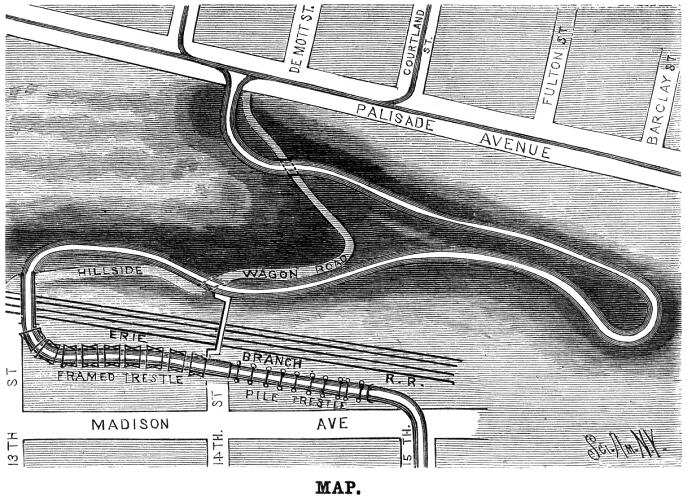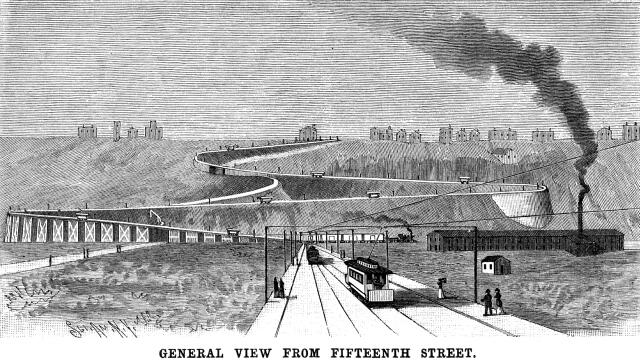THE HILLSIDE LINE OF THE
NORTH HUDSON
COUNTY RAILWAY COMPANY
Scientific American—April 21, 1894
View Looking
South
The North Hudson County Railway Company is a corporation owning
a number of miles of surface and elevated railroads in Hudson
County, New Jersey, which extend in their operations from Jersey
City to the northern line of the county. This part of the country
is characterized by the beginning of the hill which eventually
forms the basis of the Palisades. Between the river and the foot
of the elevated ground is a large area of flat land. The North
Hudson County Railway Company has to provide transportation from
the ferries on the river side to the top of the hill, involving
a rise in some cases of nearly 200 feet. There are three means
of access to the hill top—one from Hoboken Ferry by elevated
road operated by trolley; and another at the terminus of the West
Shore ferries by elevator and elevated road. We illustrate in
our present issue a third structure, by which the summit of the
hill is reached by a trolley line, known as the Hillside Electric
Road. The map and the two views show the general construction
and line of the road, and its extreme picturesqueness, in addition
to its engineering interest, will be obvious features not at all
exaggerated in our illustration. The portion of the road which
we illustrate commences at Madison Avenue and Fifteenth Street,
at West Hoboken, a point nearly opposite Fifteenth Street in this
city, and includes the interesting part, as from the ferry to
this corner it is an ordinary surface trolley road. Here the ascent
begins. By two loops it climbs the hill to Palisade Avenue, the
horizontal distance in a straight line between these two points
being 700 feet. By constructing the loops as shown a line 3,688
feet long is developed for the ascent of 160 feet. The rise begins
with a wooden trestle running nearly parallel with and to the
east of the railroad tracks of the New York, Lake Erie and Western
Railroad and of the New Jersey Central Railroad, the cars as they
ascend going almost directly south. A couple of blocks below is
a curve of 90 degrees, with a radius of 75 feet, crossing the
tracks of the railroads just mentioned on an iron truss. Going
around another curve of similar radius and of 93° 58', the
road curves along the face of the hill, gradually rising and crossing
the Hillside wagon road, which course on the ascent is now in
a general direction to the north, until at an elevation of 110
ft. it enters the northern loop, and with a radius of 60 ft. goes
around a curve of 215° 16'. The course is now to the southwest,
and, still climbing the hill, the line crosses near the 140 foot
contour line for a second time the Hillside wagon road, and going
through an arc of 100° 32' with 100 ft. radius, it reaches
its destination 160 feet above its commencement and connects with
the rest of the system.

The road is built in the most substantial manner, parts being
cut out of the face of the hill, other parts being filled and
substantial retaining walls being applied when necessary. One
of the latter is 70 feet high. Stone ballasting is used throughout,
the material of the hillside supplying the best possible material,
trap rock, for these purposes. The railroad tracks are crossed
by a 92 foot lattice girder, the most considerable bridge on the
line. Fifty-six pound steel rails are used for the cars to run
on, and these rails are re-enforced with 32 pound guard rails
laid close to them and inside. The cost of the work was $120,000
for the structural part alone. It was built by Mr. Miles Tierney
as contractor, with Mr. C. B. Brush as chief engineer. The surfacing
and finishing of the road is done tinder the immediate direction
of Mr. Wm. H. Starr, formerly of the Erie Railroad, who is now
general manager of the road and in charge of its operation. Mr.
Tierney is now president of the North Hudson County Railway Company.
 The power for the Hillside line
is supplied by a 14,000 h.p. compound Corliss engine in the power
station of the Hudson Electric Company. The power for the Hillside line
is supplied by a 14,000 h.p. compound Corliss engine in the power
station of the Hudson Electric Company.
The route involves maximum grades of 51½ per cent, and
on the curves a grade of 1½ per cent is not exceeded. The
road is reached by the Fourteenth Street Ferry, directly from
this city. On reaching the top of the hill the passenger is put
in communication at once, by means of the other lines of the company,
with all of the elevated area beginning at Jersey City Heights
on the south and ending with Guttenburg on the north. The North
Hudson County Railway Company operates about fifty miles of road,
including twenty-four miles of horse railroad, nineteen miles
of trolley and seven miles of steam railroad. A very complete
system of interchanging makes the entire area accessible. The
road carries about 17,000,000 passengers per annum.
Stories Page | Contents Page
|







